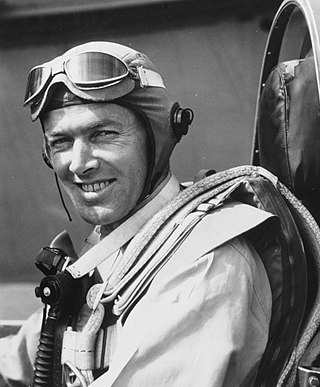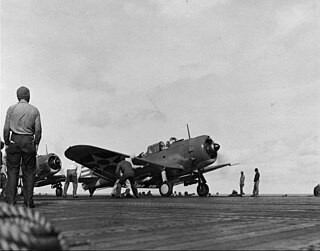
USS Enterprise (CV-6) was a Yorktown-class carrier built for the United States Navy during the 1930s. She was the seventh U.S. Navy vessel of that name. Colloquially called "The Big E", she was the sixth aircraft carrier of the United States Navy. Launched in 1936, she was the only Yorktown-class and one of only three American carriers commissioned before World War II to survive the war. She participated in more major actions of the war against Japan than any other United States ship. These actions included the attack on Pearl Harbor — 18 Douglas SBD Dauntless dive bombers of her air group arrived over the harbor during the attack; seven were shot down with eight airmen killed and two wounded, making her the only American aircraft carrier with men at Pearl Harbor during the attack and the first to sustain casualties during the Pacific War — the Battle of Midway, the Battle of the Eastern Solomons, the Battle of the Santa Cruz Islands, various other air-sea engagements during the Guadalcanal Campaign, the Battle of the Philippine Sea, and the Battle of Leyte Gulf. Enterprise earned 20 battle stars, the most for any U.S. warship in World War II, and was the most decorated U.S. ship of World War II. She was also the first American ship to sink a full-sized enemy warship after the Pacific War had been declared when her aircraft sank the Japanese submarine I-70 on 10 December 1941. On three occasions during the war, the Japanese announced that she had been sunk in battle, inspiring her nickname "The Grey Ghost". By the end of the war, her planes and guns had downed 911 enemy planes, sunk 71 ships, and damaged or destroyed 192 more.

USS Hornet (CV-8), the seventh U.S. Navy vessel of that name, was a Yorktown-class aircraft carrier of the United States Navy.

The Yorktown class was a class of three aircraft carriers built for the United States Navy and completed shortly before World War II, the Yorktown (CV-5), Enterprise (CV-6), and Hornet (CV-8). They immediately followed Ranger, the first U.S. aircraft carrier built as such, and benefited in design from experience with Ranger and the earlier Lexington class, which were conversions into carriers of two battlecruisers that were to be scrapped to comply with the Washington Naval Treaty, an arms limitation accord.

The Grumman F4F Wildcat is an American carrier-based fighter aircraft that entered service in 1940 with the United States Navy, and the British Royal Navy where it was initially known as the Martlet. First used by the British in the North Atlantic, the Wildcat was the only effective fighter available to the United States Navy and Marine Corps in the Pacific Theater during the early part of the Second World War. The disappointing Brewster Buffalo was withdrawn in favor of the Wildcat and replaced as aircraft became available.

Naval Air Station Alameda was a United States Navy Naval Air Station in Alameda, California, on San Francisco Bay.

Marine Fighter Attack Squadron 211 (VMFA-211) is a United States Marine Corps fighter attack squadron, currently consisting of F-35B Lightning II stealth STOVL strike fighter jets. Known as the "Wake Island Avengers" and the "Bastion Defenders", the squadron is based at Marine Corps Air Station Yuma, Arizona and falls under the command of Marine Aircraft Group 13 (MAG-13) and the 3rd Marine Aircraft Wing.
Fighter Squadron 11 or VF-11 was an aviation unit of the United States Navy. It was originally established as VF-5 on 1 February 1927, redesignated as VF-5S on 1 July 1927, redesignated as VF-5B in January 1928, redesignated VB-1B on 1 July 1928, redesignated VF-5B on 1 July 1930, redesignated VF-5S in July 1932, redesignated VF-5B in April 1933, redesignated VF-4 on 1 July 1937, redesignated VF-41 on 15 March 1941, redesignated VF-4 on 4 August 1943, redesignated VF-1A on 15 November 1946, redesignated VF-11 on 2 August 1948 and disestablished on 15 February 1959. It was the second US Navy squadron to be designated VF-11.

Fighter Squadron 111 (VF-111), also known as the Sundowners, was a fighter squadron of the United States Navy. Originally established as Fighter Squadron 11 (VF-11) on 10 October 1942, it was redesignated as VF-11A on 15 November 1946, redesignated as VF-111 on 15 July 1948 and disestablished on 19 January 1959. On 20 January, another squadron, VF-111 (1956-95) then assumed the designation until its de-establishment in 1995. In November 2006, VFC-13 Detachment Key West was redesignated as VFC-111, taking on the Sundowner insignia and callsign.

Fighting Squadron 10 (VF-10), also known as the "Grim Reapers", was an aviation unit of the United States Navy, established on 3 June 1942 and disestablished on 26 November 1945.

Vice Admiral James Henry Flatley Jr. was a World War II naval aviator and tactician for the United States Navy (USN). He became a fighter ace credited with shooting down six enemy aircraft in aerial combat.

USS Oswald A. Powers (DE-542) was a United States Navy John C. Butler-class destroyer escort launched during World War II but never completed.

Richard Halsey Best was a dive bomber pilot and squadron commander in the United States Navy during World War II. Stationed on the aircraft carrier USS Enterprise, Best led his dive bomber squadron at the 1942 Battle of Midway, sinking two Japanese aircraft carriers in one day, before being medically retired that same year due to damage to his lungs caused by breathing bad oxygen during the battle.

The Marshalls–Gilberts raids were tactical airstrikes and naval artillery attacks by United States Navy aircraft carrier and other warship forces against Imperial Japanese Navy (IJN) garrisons in the Marshall and Gilbert Islands on 1 February 1942. It was the first of six American raids against Japanese-held territories conducted in the first half of 1942 as part of the undertaken strategy.
Fighter Squadron 13 or VF-13 was an aviation unit of the United States Navy. Established on 2 November 1943, it was disestablished on 20 October 1945. It was the first US Navy squadron to be designated as VF-13.
Fighter Squadron 33, or VF-33, was an aviation unit of the United States Navy. Originally established as Escort-Scouting Squadron 16 or VGS-16 on 6 August 1942, it was redesignated as Composite Squadron 16 or VC-16 on 1 March 1943, redesignated as VF-33 on 15 August 1943, and disestablished on 19 November 1945. It was the first US Navy squadron to be designated as VF-33.
Fighting Squadron 2 or VF-2 was an aviation unit of the United States Navy. Originally established as VF-2 on 1 January 1927, it was redesignated VF-2B on 1 July 1927, redesignated as VF-2S on 1 July 1932, redesignated as VF-2B in April 1933, redesignated as VF-2 on 1 July 1937, it was disestablished on 1 July 1942. It was the second US Navy squadron to be designated as VF-2.
Fighter Squadron 8 or VF-8 was an aviation unit of the U.S. Navy, originally established on 1 June 1943, it was disestablished on 23 November 1945. It was the second US Navy squadron to be designated VF-8.
Fighting Squadron 72 or VF-72 was an aviation unit of the U.S. Navy, originally established as VF-7 on 1 July 1939, it was redesignated as VF-72 on 19 November 1940 and disestablished on 29 March 1943.
Fighting Squadron 9 or VF-9 was an aviation unit of the U.S. Navy, originally established on 1 March 1942, it was disestablished on 28 September 1945.
The Enterprise Air Group was established on 1 July 1938, encompassing all squadrons embarked in USS Enterprise (CV-6). The group was divided into four squadrons, each with eighteen aircraft dedicated to a particular role. The squadrons were designated according to their role, and all were given the unit number six, derived from the hull number of the Enterprise. Bombing Six (VB-6) was equipped with Douglas SBD-2 Dauntless dive bombers, Fighting Six (VF-6) with Grumman F4F-3 Wildcat fighters, and Torpedo Six (VT-6) with Douglas TBD Devastator torpedo bombers. The fourth squadron, Scouting Six (VS-6) also had the SBD-2 Dauntless, but was more focused on the scout bomber role. This air group was embarked on board the Enterprise at the time of the attack on Pearl Harbor.













